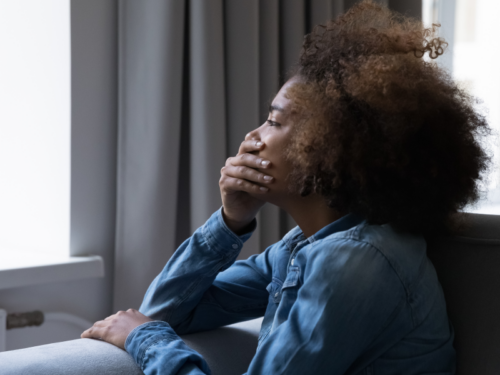
Table of Contents
The Cycle of Abuse: Understanding the Stages and How to Break Free

Written By: Ashley Laderer

Clinically Reviewed By: Cecilia Masikini
September 3, 2025
8 min.
Feeling trapped in an abusive relationship? You’re not alone. Keep reading to learn about the cycle of abuse and how it keeps you feeling trapped.
Learn more about our Clinical Review Process
Table of Contents
If you or someone you know is experiencing any type of abuse, call the National Domestic Violence Hotline at 1-800-799-7233 (SAFE) or 1-800-787-3224 (TTY) for anonymous, confidential help available 24/7.
Are you a survivor of abuse in a relationship, feeling confused and stuck, even though you know the relationship is toxic? It’s common to hold onto the affection and apologies, hoping things will change, only to find yourself back in the same painful situation over and over again.
In many abusive relationships, there is a clear pattern of repeating behaviors. Experts call this the “cycle of abuse.” Understanding each stage of the cycle can help survivors name what’s happening and break free from the abusive relationship. Read on to learn about the four stages of the cycle of abuse, how to recognize them, why the cycle makes it so difficult to leave, and what you can do to begin healing.

Healing from abuse is possible
Access virtual, trauma-informed treatment from the comfort of your home today.
What is the cycle of abuse?
The cycle of abuse is a predictable, recurring pattern of behaviors that traps survivors in a loop of fear, harm, and false hope. The cycle consists of four key stages: tension building, incident, reconciliation, and calm.
“The cycle of abuse perpetuates itself through distinct phases: tension, where fear and instability build, an incident of abuse, and a honeymoon or reconciliation period, where the abuser apologizes and promises change,” says Nicole Lonano, MS, Group Facilitator at Charlie Health. “This pattern creates a psychological trap for the victim, as the temporary relief and affection of the honeymoon phase make it difficult to leave, reinforcing the abuser’s control and repeating the cycle.”
The concept was developed by psychologist Lenore Walker, who outlined the cycle in her 1979 book, The Battered Woman. Walker’s research among women who were survivors of intimate partner violence found that abuse often followed a recognizable cycle, which she called the “Cycle of Violence.” Although it was originally meant to describe the patterns of domestic violence, experts now recognize that the cycle can apply to other types of abuse as well.
The four stages of the cycle of abuse are as follows:
Stage 1: Tension building
“During this stage, the signs of abuse and behaviors slowly increase in intensity and frequency,” Lonano says. “This can be related to external stressors, such as financial stressors, interpersonal challenges in environments, and health challenges.” She notes some signs of these behaviors include:
- Irrilitability
- Impatience
- Short temper
- Emotional outbursts
As tension noticeably builds, Lonano says the non-abusive partner may feel like they’re walking on eggshells and experience heightened anxiety and fear. They may also feel an increased need to please their partner in hopes of preventing an outburst.
Stage 2: Incident
This is the stage where the tension breaks and the actual abusive event takes place. An abusive incident can include:
- Domestic violence/physical abuse (including sexual assault or rape)
- Emotional abuse (including psychological abuse or verbal abuse)
- Financial abuse
Additionally, Lonano says the incident can escalate with every abuse cycle. This means that over time, the severity or intensity of the abuse may increase, putting the survivor at greater risk of physical and emotional harm.
Stage 3: Reconciliation
After the abusive behavior, the abuser may enter into damage-control mode to repair the relationship and prevent the survivor from leaving them.
“The abuser may make amends, apologize, shower you with affection, and make promises they will never do it again,” Lonano says. “The abuser may seem genuinely ashamed of their behaviors, and because the other individual cares about them, they may feel inclined to believe what they are saying and give them another chance.”
The reconciliation stage can include gift-giving, love bombing, and grand romantic gestures to try to win back trust and affection.
Stage 4: Calm
This phase isn’t actually very “calm.” Although the relationship might temporarily feel back to “normal,” the abuser is engaging in behavior that keeps their partner trapped. Lonano says that during this phase, an abuser may:
- Shift from being apologetic to making excuses for their behaviors
- Shift responsibility for the abuse
- Try to justify their behavior
- Gaslight the receiver of the abuse, making them question their reality
“This stage can feel confusing because the abuser may seem to want to make things right, but there is an underlying tone of dismissal you can’t identify,” Lonano says. After a while, unresolved tension starts to build again, and the abusive cycle repeats.
Why do people stay in the cycle of abuse?
“The cycle of abuse — involving repeated patterns of tension, incident, reconciliation, and calm — can make leaving incredibly complex,” says Bree Williams, LPCA, a Group Facilitator at Charlie Health.
Whether you are a victim of psychological, physical, or sexual abuse, here are some reasons you may remain in the cycle.
1. Fear of retaliation or harm
You might be scared to leave your abusive partner, due to threats or previous physical violence. “Abusers may threaten physical, emotional, or financial harm if their partner tries to leave,” Williams says.
2. Financial dependency
Unfortunately, many victims in abusive relationships are unable to leave if they’re financially dependent on the abusive individual. If you lack independent access to financial resources, you may feel even more trapped in the abusive relationship, says Williams.
3. Low self-worth
“Constant criticism and manipulation can make survivors believe they deserve the abuse or can’t do better,” Williams says. This is classic behavior for emotionally abusive partners, and also common in narcissistic abuse.
4. Isolation
Abusers often purposefully isolate you from your friends, family, and overall support systems, making it harder for you to reach out for help, Williams says. This is a popular abuse tactic that keeps victims reliant on the abuser.
5. Trauma bonding
“Trauma bonding occurs when a survivor forms an intense emotional attachment to their abuser due to repeated patterns of abuse mixed with intermittent kindness or affection,” Williams says. “In abusive dynamics, the brain becomes conditioned to seek safety from the same person causing harm.” This trauma bond reinforces emotional dependency on the abusive individual.
6. Hope for change
When you love someone, you want to believe they can be better and change. Periods of calm and affection create false hope that survivors may cling to, Williams says.
It’s also important to note that although many abusive relationships do follow this predictable four-stage cycle, they don’t always, Lonano says. “Violence rarely occurs in a predictable cycle, and can show no patterns,” she explains. “It’s crucial to understand that all forms of abuse are harmful, regardless of whether they fit the cycle or not, and every situation needs to be addressed on its own.”
What are the mental health impacts of the cycle of abuse?
Abusive relationships can take a major toll on your mental health and well-being, resulting in both short-term and long-term impacts.
Short-term impacts of abuse
In the aftermath of abuse, survivors often experience mixed feelings as they try to process what’s happened. Williams says some short-term impacts include:
- Increased anxiety
- Hypervigilance
- Low self-esteem
- Confusion
- Feelings of shame and guilt
- Difficulty concentrating
- Trouble sleeping
These factors can contribute to trouble regulating your emotions, social isolation, and withdrawal from activities you usually enjoy, Lonano adds.
Long-term impacts of abuse
Long-term effects of abuse can cause significant impacts that last even after an abusive relationship has ended. Williams says some long-term impacts include:
- Chronic depression
- Anxiety disorders
- Difficulty trusting others
- Difficulty forming healthy relationships
- Emotional numbness or dissociation as a survival response
- Post-traumatic stress disorder (PTSD) or complex PTSD (C-PTSD)

Here’s How Intimate Partner Violence Impacts Survivors’ Mental Health
Sarah duRivage-Jacobs
How to leave an abusive relationship and heal
“Breaking free is not easy, but it is possible with support and intentional steps,” William says. Every survivor’s path looks different, but here are five common strategies that can help you move toward safety and healing from an abusive relationship.
1. Build a safety plan
If you have not yet left the relationship, having a safety plan is key. This plan is meant to help you prepare for high-risk situations and protect yourself in moments of crisis. You want to know who you can call, where you can go, and how to safely leave if you’re in danger, Williams says.
The National Domestic Violence Hotline has helpful resources for creating this plan. You can also contact the Hotline 24/7 (via call, text, or online chat) to create a safety plan with the help of a trained advocate.
2. Educate yourself about abuse
“Understanding the psychological patterns of abuse and trauma bonding can empower you to separate emotional attachment from reality,” says Williams. Learning how abusers operate can reduce self-blame and guilt. It’s helpful to know that you’re far from the only one experiencing this cycle, and the abuse is not your fault.
3. Strengthen your support network
Leaning on social support during this time is key. You might feel lost and lonely after leaving a relationship, even when you know it was an unhealthy and dangerous one. Surround yourself with people who validate your experience and remind you of your worth. Williams suggests connecting with trusted friends, family, or even support groups for validation and practical help. These trusted individuals can also help keep you from returning to the abuser after you’ve left them.
4. Practice self-compassion
Self-compassion means treating yourself with kindness, speaking to yourself the same way you would to a loved one. “Leaving an abusive relationship is a process, not a single moment,” Williams says. “Be patient and gentle with yourself as you heal.”
Keep in mind, healing won’t happen overnight, and it’s normal to feel mixed emotions and uncertainty as you rebuild your life without your abuser in it.
5. Seek therapy
Therapy is a key component in healing from any type of trauma, including abuse. Williams recommends working with a trauma-informed therapist who can help you process emotional wounds and rebuild your sense of self-worth. “Modalities like EMDR, CBT, and somatic therapy can be especially helpful,” she adds.

How Charlie Health can help
If you’re a survivor of abuse hoping to heal, Charlie Health can help. Our virtual Intensive Outpatient Program (IOP) provides more than once-weekly mental health treatment for people dealing with mental health conditions—including those that can result from the cycle of an abusive relationship, like PTSD, C-PTSD, anxiety, and depression.
Our compassionate, trauma-informed clinicians incorporate evidence-based therapies into individual counseling, family therapy, and group sessions. With this kind of support, you can reclaim your sense of self and create healthier relationships moving forward. Fill out the form below or give us a call to start your healing journey today.




